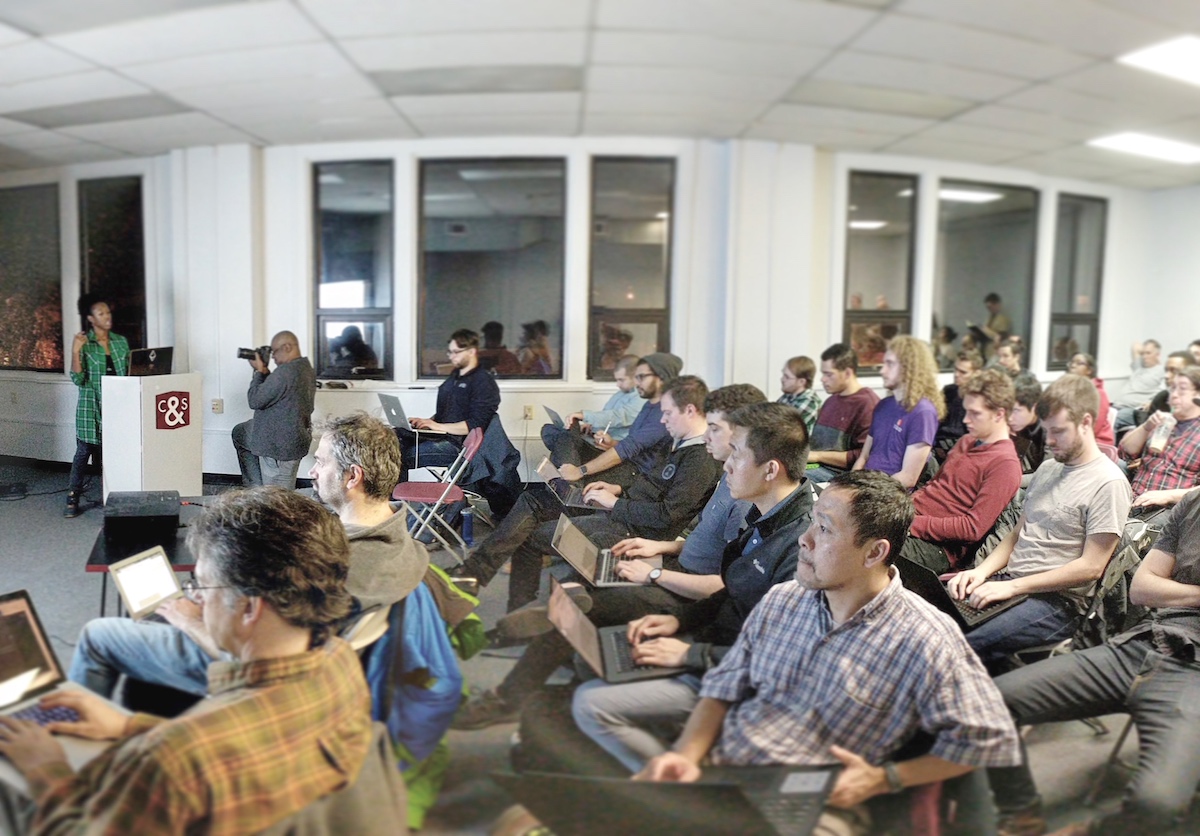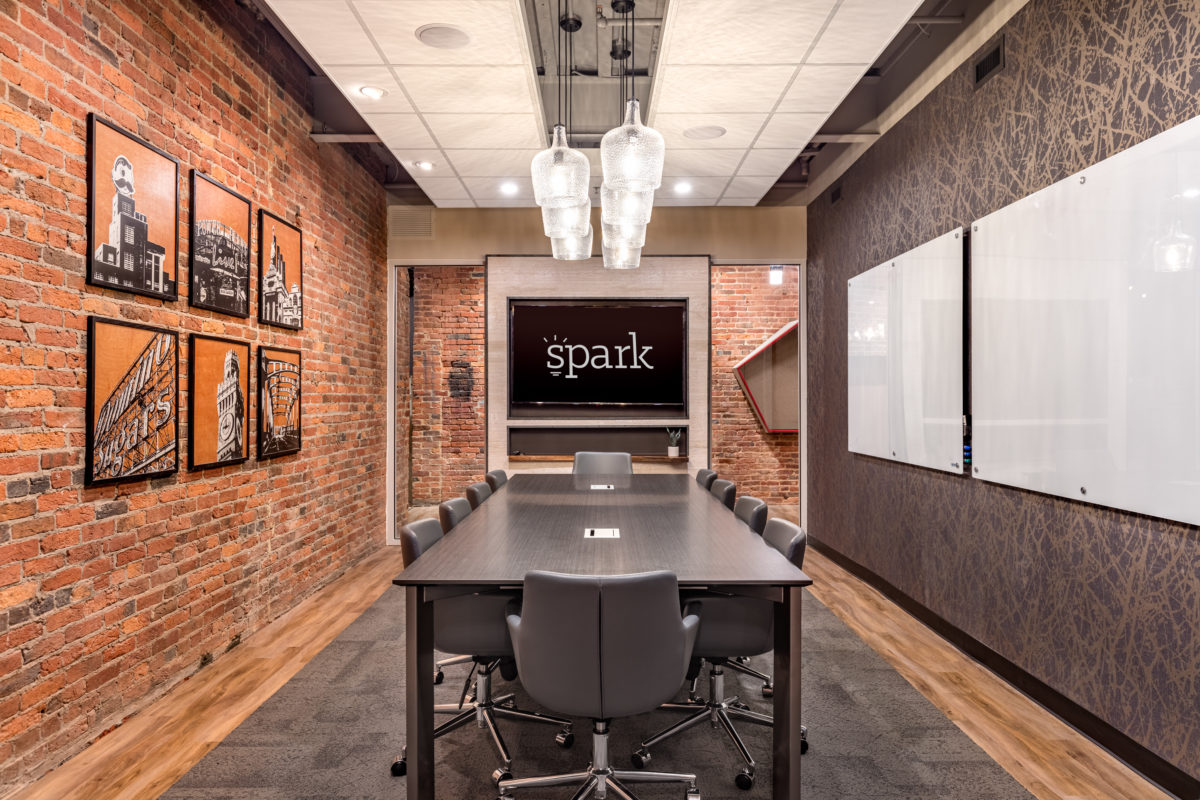Even as most of the talk was about working from home over the last 18 months, many of the coworking spaces that have become a gathering point for entrepreneurs were open for most, if not all, of this pandemic-stricken period.
As with many public spaces, it was by no means business as usual. Out of seven coworking companies in the mid-Atlantic, two said they closed for at least some portion of the pandemic. Others said fewer people passed through their doors. In the meantime, leaders made adjustments for safety, and pivoted programming.
Yet the community hubs found a way to keep going. Ultimately, it was about serving members.
“Some of our members were considered essential during the extensive lockdown, and now that everything is open again, we are seeing our folks return,” said Rebecca Parsons, director of operations and employee #2 at The Mill, which operates two coworking spaces drawing companies from a mix of industries in and around Wilmington, Delaware.
Parsons was speaking during an AMA on coworking and community hosted earlier in September on Technical.ly’s public Slack. The lunchtime gathering put a bookend on Technical.ly’s How We Work Now Month.
Join the SlackEven as they stayed open, coworking spaces had plenty of challenges. There were fewer people in the spaces, even though they were open. So making the connections that coworking has come to be known for didn’t come as automatically. That meant a key objective was keeping the community between people that’s so often at the heart of the colorful, cozy spaces they maintain. Seeing as how such spaces remain on the forefront of future trends in the workplace, there are plenty of lessons to glean from how they adjusted during the pandemic.
Listening to members
Staring down a pandemic that meant limits on contact between people for health and safety reasons, coworking leaders knew they would have to make changes. So they followed the approach that many of the fledgling companies in their spaces employ, and went out to talk to users.
Spark Coworking, which has Baltimore, St. Louis and Kansas City spaces, held community town halls to share policy updates and provide other updates. The team is also holding one-on-ones with members as a mental health check.
This brought a shift in tactics to meet members where they were. Charlotte Lee, president of Philadelphia-based, three-state incubation network 76 Forward, which saw major shifts as it rebranded from 1776 to center equity and closed spaces in DC and Philly, said the feedback led its spaces to run more foundational workshops on the basics of running a business. It was fitting for a time when businesses were redrawing plans in the wake of an economic shock.
Even when members weren’t coming in, leaders sought to keep in touch. Much of the programming run at coworking spaces went virtual, giving those working from home access. For Mike Madden, who runs three Avenu coworking spaces in the Pittsburgh Innovation District, it has brought into focus how folks can be separate but still connected. They don’t have to be literally side-by-side.

“We’ve realized our members want to come into our spaces to focus, put their head down and work but still desire — perhaps even more now — the feeling of community,” he said. “We’ve seen a demand increase for private offices where people can retreat to their work but want to be out of the house [or] office to chat and be with others. We’re philosophically embracing co-community as much as co-working.”
It’s a reminder that what started during this time can become permanent. At Code & Supply, a Pittsburgh-based software community that includes a physical space for engineers, designers and technologists, a Slack channel focused on mental health turned into a biweekly video chat that has since become a weekly event on Fridays.
At REC Philly — which operates 10,000 square feet of creative space in Center City Philadelphia with studios for art, audio, photo, dance, yoga and video, as well as a concert venue, coworking and cafe — a regular event called Brave Space that started in summer of 2020 became a necessity in a pandemic and racial justice movement for its 1,100-member community. Cofounder William Toms said it was an event “where we just held space for members to be real about what we were all experiencing through covid, the uprisings and everything else last year. What we all learned about each other in those sessions was incredible — you learn how different AND the same we all are. Beautiful.”
(Find more on REC Philly’s pandemic moves here.)
So, what changed?
Like most businesses, coworking spaces had to pivot. For one, leaders had to shift where the community was coming together. Slack communities are way more active, for one. Events also continue to be important, even as they’re held virtually.
Code & Supply pivoted Heartifacts, its conference for software developers that provides mental health and community discussions, to virtual. It even found a paying audience, as the organizers decided to charge for participation, rather than content: Anyone could watch live, but payment was required to chat or ask questions.
At REC Philly, the pace of events slowed down, as what was once a 20- to 25-event-per-month cycle is now about eight IRL and virtual happenings. Cofounder David Silver said the overall impact is still the same.
“The whole shutdown helped us realize that sometimes less is more,” he said.
Some traditions remained. In a year when it opened two new locations, Spark kept the multi-year tradition of Every Startup’s Holiday Party in place. The coworking community started the event to offer young companies without the infrastructure to host a holiday party a chance to celebrate with a team. Swag boxes and themed Zoom breakout rooms helped the team keep it going virtually, said Shervonne Cherry, Spark’s director of community and partnerships.

Cambridge Innovation Center — aka CIC — which has eight sites in innovation districts globally that provide space, community, and services for entrepreneurs, created a COVID-19 testing business called CIC Health.
“They took a clear challenge to their core business and built an innovative solution that not only made money through the pandemic, but helped a ton of people,” said John Heinz, the assistant director of sales and relationship management, who was inspired to join the team three months ago on hearing of this approach.
There were also pivots in how community managers approached members. At The Mill, video content that included interviews with members helped them stay connected to each other.
Spark Baltimore Community Manager Maggie Terhune got creative with how she made introductions between members.
“When onboarding a new member or company I always introduce them to a few key members whose work align with their business, would benefit their business or who would get along personality wise,” she said.
###
The Slack chat had way more info than we can provide in a cogent article, but here’s a lightning round with more gems on facilitating community:
Shervonne Cherry, Spark Coworking
“Over communication is key. We saturate our members with information on diverse platforms so we ensure they have the info they need. They have SO such going on with their companies and personal life, that we want them to know they are 100% our focus. Also creating space for members to either freely express concerns or privately vent was a core of our mental health support for our community.”
David Silver, REC Philly
“Another thing that I thought worked well was creating grant programs where our community could access funding during these tough times. I noticed our community rallying around these opportunities and supporting each other to make sure people saw the opportunities, congratulated folks who received the grants, and much more.”
Charlotte Lee, 76 Forward
“We are starting to offer package memberships to larger companies who are now offering hybrid work options. We give them, for example, 10 desk memberships for a team of 30 who come in on a rotating basis, and provide a certain number of conference room hours so the whole team/different departments can work/collaborate in person as needed.”
Rebecca Parsons, The Mill
“We turned vacant offices into breakout spaces which worked really well. We took the vacancy and made it into an amenity. It boosted one-off and repeat usage of the space. It provided members with a space to get out of the community area, and allowed non-members to rent space for things like bar exams which is great.”
Mike Madden, Pittsburgh Innovation District/Avenu
“Quality of life matters more than ever. Coworking spaces need to reflect or at least somewhat resemble the spaces people have made for themselves to work at home. We need to provide the best of both worlds — the productivity of an office and the comfort of your home office.”
Maggie Terhune, Spark Baltimore
“Coworking (to me) has always been the future of work, the pandemic really just pushed the timeline up! Companies of all sizes and industries are now realizing they can have their teams within a community space with flexible lease terms, no overhead, plug and play meeting rooms and countless other amenities. This frees up time for them to focus on the building the business itself. A no brainer!”
Colin Dean, Code & Supply
“[Hybrid work] was 100% a great model and I desperately want to return to it. We all felt productive daily and that team still raves about how productive they felt. Trust people to get stuff done, measure results instead of micromanaging technique, let craftspeople work where their flow is greatest but make them work in the same room once in a while to take advantage of congregationalism.”
John Heinz, CIC
“Coworking, by design, smooshes as many people as possible into a shared space to work and commune-not a very good business model during a pandemic of an airborne respiratory virus. Despite that, I do think that coworking is the future. The traditional office is dead. An increasing number of people will likely have some form of hybrid or remote work moving forward. But we have real human needs for community, for belonging, for place. Coworking spaces provide that. I think how coworking spaces provide those things will change in the years to come as now people have more freedom than ever to choose where and next to whom they will work.”







